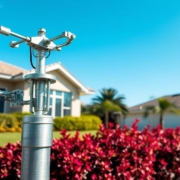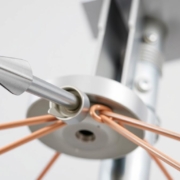University Surge Protection Systems: Safeguard Your Campus
A single lightning strike near a Texas campus caused $1.2 million in damages to unshielded security devices last year. This shocking event highlights the hidden risks modern institutions face from electrical disturbances. With sensitive technology now powering everything from emergency alerts to research labs, campuses must rethink their defense strategies against invisible threats.
Advanced security networks and communication tools form the backbone of campus operations. Yet these critical assets remain exposed to voltage spikes that can strike without warning. Studies show 70% of equipment failures stem from transient surges – not sudden storms. Even minor fluctuations in power quality can cripple access controls or erase surveillance data.
The financial consequences of inadequate safeguards extend far beyond repair bills. A Minnesota college lost three weeks of operations after surge-related network failures disrupted campus-wide safety protocols. Proper mitigation strategies blend code-compliant hardware with expert installation – a combination that prevents catastrophic downtime.
Protecting vital infrastructure requires specialized knowledge of electrical behavior and local climate patterns. Certified professionals analyze risk factors unique to each facility, from lightning frequency to grid reliability. Don’t wait for disaster to strike – proactive measures ensure continuity for life-saving systems when they’re needed most.
For tailored solutions that shield your critical assets, call our certified team at (813) 630-2757. We implement defense strategies that meet NFPA standards while adapting to your campus’s specific needs.
Understanding the Importance of Surge Protection in University Campuses

In 2023, a major college’s surveillance failure led to 19 days of manual security protocols and $78,000 in unexpected costs. This incident underscores how modern safety tools – while essential – create complex vulnerabilities when unprotected. Electrical disturbances don’t just break devices; they fracture entire emergency response chains.
When Safety Networks Become Liability
IP-based cameras and smart locks form a digital nervous system for campuses. But their network connections act like highways for destructive power spikes. A Southeastern institution learned this harshly when a lightning strike traveled through a security camera to fry servers and 47 student laptops. “The damage spread faster than our IT team could react,” their facilities manager noted.
These cascading failures disable more than hardware. During outages, staff must:
– Manually check building access
– Deploy temporary guards
– Revert to paper-based logs
This operational chaos often costs 3-5 times the actual equipment replacement.
The Hidden Price of Power Spikes
Beyond fried servers lies a web of secondary expenses. One Midwest college paid $32,000 for emergency security personnel after their access controls failed during finals week. Liability risks soar when emergency alerts go silent – some institutions face six-figure insurance premium hikes post-incident.
Modern solutions require layered defense strategies. Quality suppressors at network junctions can block 95% of transient spikes. Combined with grounding upgrades, they create safety nets that keep critical infrastructure online during storms. Proactive measures aren’t just about preventing damage – they’re about maintaining trust in campus security.
Risks and Threats: Lightning Strikes and Power Surges

A Midwest institution nearly lost $2.3 million in broadcast contracts when their stadium’s lighting controls failed hours before kickoff. This near-disaster reveals how electrical threats can strike critical infrastructure without warning.
Campus Lightning Strike Incidents
Direct hits create catastrophic chain reactions. When lightning struck Prospect School’s clock tower, flames spread through network conduits to seven buildings. Firefighters contained the blaze, but 10 months of repairs displaced 1,400 students. Similar incidents at McLane Middle School and Marian Central Catholic High School demonstrate lightning’s unpredictable paths.
Electromagnetic pulses from nearby strikes prove equally destructive. A Florida campus lost 83% of its security cameras during a storm that never physically touched grounds. “The surge traveled through underground fiber lines,” their IT director explained. “We didn’t realize data cables needed shielding too.”
Consequences of Power Surges on Campus Equipment
Voltage spikes silently degrade systems between major events. Athletic complex HVAC units failed at Old Eastaboga School after years of minor grid fluctuations. Maintenance logs showed capacitor wear 300% faster than manufacturers predicted.
| Surge Source | Common Entry Points | Typical Damage |
|---|---|---|
| Lightning strikes | Outdoor lighting, metal roofs | Instant equipment failure |
| Grid switching | Utility connections, transformers | Cumulative component wear |
| Equipment faults | Internal wiring, shared circuits | Data corruption |
Parking lot emergency stations and networked door locks create multiple surge pathways. A single compromised device can disable entire safety networks, forcing manual overrides during critical moments. Proactive monitoring identifies vulnerabilities before they escalate into campus-wide crises.
Key Components and Specifications of Surge Protection Devices
Modern electrical defense relies on precise technical specifications that determine effectiveness. Three metrics separate basic suppressors from professional-grade solutions: clamping voltage, energy absorption capacity, and installation flexibility.
Clamping Voltage and Joule Ratings Explained
Clamping voltage acts like a security checkpoint for electricity. When transient spikes exceed this threshold (typically 330V for standard circuits), the protector activates within nanoseconds. Lower values offer tighter control but may shorten a device’s lifespan during frequent disturbances.
Joule ratings reveal total stopping power. Industrial models absorb over 1,000 joules per event – equivalent to blocking 40,000 amps of rogue energy. This capacity determines how many major surges a protector can neutralize before requiring replacement.
Modular vs. Non-Modular Device Options
Plug-and-play modular units simplify maintenance for non-critical systems like classroom AV equipment. Technicians replace them without rewiring, minimizing downtime. Hardwired protectors prove more durable for fire alarms and access control panels, though upgrades demand scheduled outages.
Response times under 1 nanosecond protect sensitive lab instruments from microsecond spikes. Pairing fast-acting protectors with proper grounding creates layered defense networks. As one facilities manager noted: “The right specs prevent both instant catastrophes and slow system degradation.”
Implementing University Surge Protection Systems: Best Practices
Effective electrical defense for educational institutions requires strategic layering of safeguards across three critical zones. The ANSI/IEEE C64.41.2-2002 standard defines these protection levels, creating a roadmap for comprehensive defense strategies.
Tailoring Systems for Diverse Facilities
Different campus environments demand customized solutions. Research labs with sensitive instruments need Category A protection at equipment level, while athletic complexes require heavy-duty suppressors for outdoor lighting systems. Fire alarm circuits and network servers each have unique voltage tolerance thresholds.
| Category | Location | Protection Scope | Device Examples |
|---|---|---|---|
| C | Service Entrance | Whole-campus defense | 200kA arrestors |
| B | Distribution Panels | Building-level protection | Panel-mounted SPDs |
| A | Equipment Points | Device-specific safety | Plug-in suppressors |
Seamless Infrastructure Integration
Successful implementation coordinates with backup generators and existing circuit breakers. Certified technicians should verify compatibility between new suppressors and legacy electrical panels. “Our campus-wide upgrade maintained 100% uptime during installation,” noted a facilities director from Ohio.
Proper sizing prevents overload risks. For example, dormitory HVAC units need suppressors with 50kA minimum ratings, while library servers require faster response times under 1 nanosecond. Regular load testing ensures continuous protection as power demands evolve.
Design and Installation Guidelines for Optimal Protection
Proper implementation of electrical safeguards requires precision in both layout and execution. A Georgia technical school reduced equipment failures by 89% after redesigning their defense strategy around three core principles: proximity, conductivity, and verification.
Strategic Device Placement
Position suppressors within 3 feet of sensitive equipment to minimize exposure risks. Outdoor cameras and access points need protectors at each entry point – cable length directly impacts effectiveness. One campus IT director noted: “Shorter wire runs between devices and suppressors cut our repair costs by half.”
Follow these critical placement rules:
– Install primary protectors at main service panels
– Place secondary units near equipment clusters
– Mount weatherproof models outdoors
Effective Grounding Techniques
Proper grounding creates escape routes for dangerous energy. Use 6 AWG copper conductors for main connections, ensuring resistance stays below 1 ohm. Grounding conductor integrity proves vital – corroded joints can triple surge damage potential.
Annual testing identifies weakening connections before failures occur. Combine building steel, water pipes, and ground rods into a unified system. This approach helped a Florida college prevent network outages during hurricane season despite 17 nearby lightning strikes.
Maintenance and Inspection Protocols for Surge Protection
Arizona State’s facilities team discovered corroded wire nuts during a routine check – a small oversight that nearly disabled their entire access control network. This near-miss illustrates why consistent evaluations form the backbone of reliable electrical defense strategies.
Routine System Evaluations
Quarterly inspections prevent silent failures. Technicians verify connection tightness using calibrated torque wrenches and test grounding paths with micro-ohmmeters. Indicator lights provide instant status checks, but physical verification remains essential.
| Inspection Task | Frequency | Tools Required | Purpose |
|---|---|---|---|
| Ground resistance test | Biannual | Earth ground tester | Ensure |
| Connection integrity check | Quarterly | Infrared thermometer | Detect loose terminals |
| Event log review | Monthly | Monitoring software | Track surge activity |
Identifying Replacement and Upgrade Needs
Protectors don’t fail suddenly – they degrade with each absorbed spike. A Missouri campus replaced 23 suppressors last year after noticing faded indicator lights and increased event log frequency. “Waiting for complete failure risks collateral damage,” warns a certified inspector from Florida.
Modern monitoring systems automatically flag devices exceeding 80% capacity. Annual load assessments identify circuits needing upgraded joule ratings. Documentation proves critical – one Ohio school recovered $41,000 in warranty claims using properly maintained service records.
Standards and Compliance: Meeting U.S. Safety Regulations
Compliance failures cost a Virginia medical campus $240,000 in fines last year when outdated suppressors violated updated UL standards. This incident underscores how evolving electrical codes demand continuous system reviews. Modern safety protocols require alignment with three core benchmarks: device certification, installation quality, and documentation rigor.
Understanding ANSI/IEEE and UL Guidelines
The UL 1449 standard transformed device testing in 2009 by introducing voltage protection ratings (VPR). This update mandated sixfold increases in current loads during certification – a critical upgrade for handling lightning-induced surges. ANSI/IEEE C62.41 defines minimum 10kA protection thresholds, simulating real-world scenarios where 20kA strikes split across building circuits.
| Standard | Focus Area | Key Requirement |
|---|---|---|
| UL 1449 | Device Safety | VPR certification |
| ANSI/IEEE C62.41 | Performance | 10kA surge handling |
| NEC Article 242 | Installation | Code-compliant placement |
Certified technicians must cross-reference these guidelines during installations. “Mismatched suppressors create compliance gaps even with proper hardware,” warns a Florida-based inspector. Third-party validation ensures devices meet both energy absorption capacities (measured in joules) and response time specifications.
Annual audits protect institutions from liability while maintaining system effectiveness. Documentation proving adherence to ANSI/IEEE selection criteria becomes vital during insurance reviews or incident investigations. Proactive compliance isn’t just regulatory – it’s financial risk management.
Exploring Advanced Surge Suppressor Technologies
Modern electrical defense now tackles two distinct battlefield fronts – visible lightning strikes and invisible energy spikes. Next-gen suppressors deploy specialized tactics for power grids and data networks, each requiring unique defensive postures.
Power vs. Data/Telecom Surge Protection
Suppressors for electrical systems follow ANSI/IEEE C64.41.2-2002 zones. Category C units near main panels neutralize 20kV threats, while Category A devices shield equipment over 60 feet away. Data protectors use gas tubes and semiconductors to filter interference through network cables without slowing transmissions.
Innovative Protective Features and Capabilities
Top-tier devices absorb multiple strikes through self-heating metal oxide varistors. Smart protectors send real-time alerts via mobile apps when energy absorption reaches 80% capacity. Thermal fuses automatically disconnect during extreme events, while weatherproof housings withstand corrosive outdoor environments.
These advancements create layered defense networks that adapt to evolving threats. Properly implemented systems maintain operational continuity through back-to-back storm seasons – a critical advantage for institutions managing vital infrastructure.









